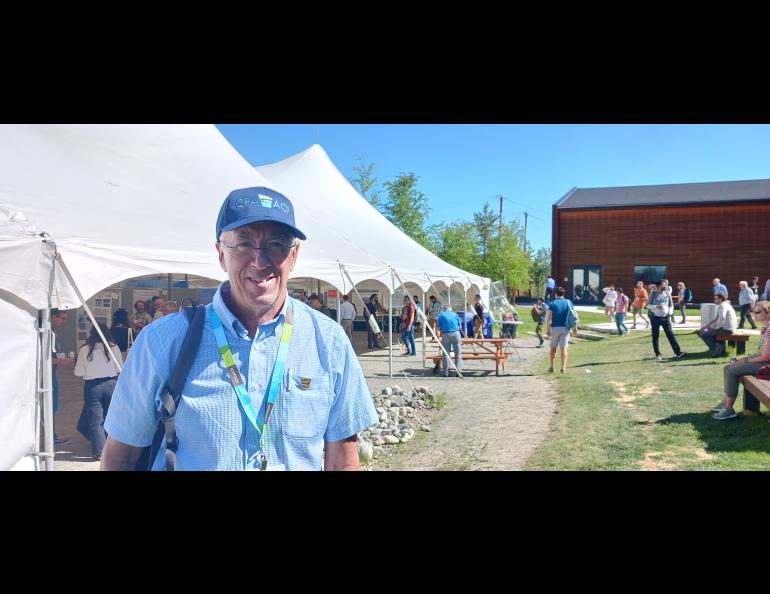WHITEHORSE, Yukon — Universities play an essential role in advancing permafrost science, the president of the Canadian Permafrost Association said this week at an international conference in Whitehorse, Yukon, attended by several University of Alaska Fairbanks scientists.
Universities such as UAF and Yukon University perform necessary research that isn’t cost effective for the private sector.
“Without the universities, we would be way behind where we are now,” said Guy Doré, in his first year as Canadian Permafrost Association president. He is also chairman of the association’s board of directors.
Doré was a visiting faculty member at the University of Alaska Anchorage from summer 2003 to summer 2004 but was based in Fairbanks. He gave lectures through the UAF College of Engineering and Mines.
“I wanted to be where the action is in permafrost research,” he said.
Permafrost underlies approximately 25% of the Northern Hemisphere’s exposed land surface, according to the U.S. National Snow and Ice Data Center. It is thawing as the climate warms, affecting infrastructure such as buildings and roadways. Thawing permafrost also alters an area’s hydrology and wildlife.
Doré has been studying permafrost engineering for nearly 40 years, 25 of those as a researcher with expertise in cold regions engineering applied to transportation infrastructure. He is professor emeritus at the civil and water engineering department at University of Laval in Quebec.
“The universities do the more fundamental research, the modeling. That's not something that's cost effective to do if you're in a consulting firm,” he said in an interview on a sunny day outside the conference center in Whitehorse, Yukon.
“So we need the universities, the students, to spend the time to dig into the information, to do the crunching of the numbers, to look at the trends," he said.
The Canadian Permafrost Association is hosting the International Conference on Permafrost. This is the 12th conference, which is now held every four years. This is the first, however, since the 2016 conference in Potsdam, Germany. The 2020 conference in China was canceled because of the COVID pandemic.
Doré has seen an acceleration in the field of permafrost science over his lengthy career.
“It progresses very fast,” he said. “Once upon a time, permafrost was considered something permanent. You could build on permafrost. And you would be stable forever if you followed a couple of simple rules.”
Doré said the current state of permafrost research is mixed.
“We have to increase our knowledge,” he said. “And that is something that we're doing well. The science on permafrost in Alaska, Canada, Europe and Russia is very high level.”
“There are more people studying permafrost,” he said. “We have better tools to study permafrost. Our capacity to drill, to instrument, to monitor and to model has increased significantly in the last couple of decades. And we are doing pretty good on the engineering side.”
But more needs to be done.
“We're not doing enough in the way we cope with problems,” he said. “We need more cost-effective methods to mitigate permafrost degradation. We need new ideas, because we're limited to a relatively small number of methods that we can use to stabilize the ground.”
“We need to be able to use natural materials and natural phenomena like convection,” he said. “So that's something that requires a little bit of research attention.”
Universities can help by having a multidisciplinary approach to permafrost science and by working with the practical world and with communities, including those of Indigenous peoples.
“You cannot work in your own garden and do your own things,” he said. “We need to work closely with communities, with the consulting world and with the construction world.”
Northerners — Indigenous and non-Indigenous — have a lot to offer, Doré said.
“We cannot go around indigenous people. It's their land, it's their communities,” he said. “They know a lot about permafrost and how to cope with permafrost because they've lived on permafrost for generations. They have the traditional knowledge that can help a lot.”
“It's very important for scientists to work with indigenous people and to also work with non-Indigenous people who live in the north, because also they have expertise and know what the North is about.”
As to this year’s conference, Doré said he is impressed by the research he has seen and heard.
“The technical content is just amazing,” he said. “It’s a really high-quality conference. There are lots of people who are presenting research for the first time, and it’s really high quality.”

